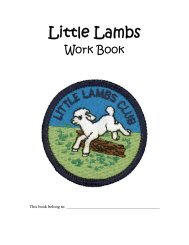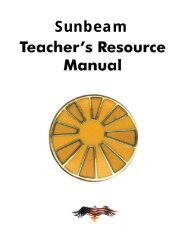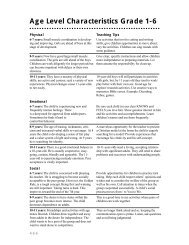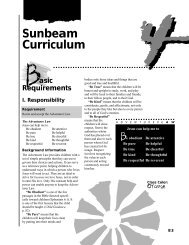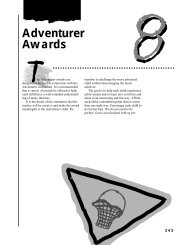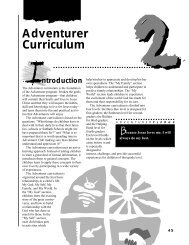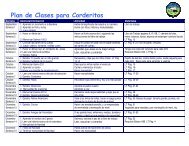Busy Bee Curriculum - KFW Adventurers
Busy Bee Curriculum - KFW Adventurers
Busy Bee Curriculum - KFW Adventurers
You also want an ePaper? Increase the reach of your titles
YUMPU automatically turns print PDFs into web optimized ePapers that Google loves.
C H A P T E R T H R E E B U S Y B E E<br />
○ ○ ○ ○ ○ ○ ○ ○ ○ ○ ○ ○ ○ ○ ○ ○ ○ ○ ○ ○ ○ ○ ○ ○<br />
Hurting oneself or other people or things is<br />
not a good way to deal with negative feelings.<br />
Neither is lying, running away from the<br />
problem, or thinking a lot of negative<br />
thoughts about yourself or others. Negative<br />
feelings can be dealt with by looking for a<br />
solution such as:<br />
✏ Talking honestly with someone about<br />
your negative feelings<br />
✏ Finding out more about the problem<br />
and working to change it<br />
✏ Being alone for a while<br />
✏ Working out your feelings in a harmless<br />
way, such as crying, drawing or<br />
writing, or kicking a ball; or<br />
✏ Telling yourself positive, helpful things<br />
Obviously, different solutions are appropriate<br />
for different situations, feelings and people.<br />
At a very early age, children can begin to<br />
learn to recognize their feelings and to talk<br />
with someone about the feelings they have<br />
and how they can deal with these feelings.<br />
They can learn to communicate their feelings<br />
in a kind way to helpful adults and to the<br />
person(s) who provided those feelings. Kind<br />
communication of feelings involves both<br />
choosing the words carefully and speaking in<br />
a kind manner. An adult can help the child<br />
decide how to communicate his/her feelings<br />
by helping him/her to choose appropriate<br />
words as well as an appropriate time and<br />
place to share such feelings.<br />
feeling. (You may use the steps for<br />
dealing with negative feelings suggested<br />
in the Background Information,<br />
along with the accompanying<br />
poster in the “My Self” section of the<br />
appendix.)<br />
When I Feel Bad<br />
I Can…<br />
Tell Jesus how I feel and ask<br />
Him for help.<br />
Ask myself:<br />
“What am I feeling?”<br />
“Why am I feeling this way?”<br />
“What shall I do about it?”<br />
“Is this a good thing to do?”<br />
Do what I decide to do.<br />
Teaching Tips<br />
The Feelings Game<br />
1. With the children, brainstorm different<br />
kinds of feelings and write each one on<br />
a small card or piece of paper.<br />
2. Place the feelings cards in a bag or box.<br />
3. Divide the children into groups of two<br />
or three and allow each group to draw a<br />
feelings card.<br />
4. Instruct the groups to practice showing<br />
how they might look when they have<br />
that feeling (body language). Each<br />
group should also be ready to tell or act<br />
out a situation in which they have felt<br />
that way.<br />
5. After each group presents their feeling<br />
to the entire group, talk about ways in<br />
which God can help us deal with that<br />
This is a sample of the “When I feel Bad I<br />
Can…” poster. A reproducible copy can be<br />
found in the “My Self” section of the<br />
Appendix.<br />
473<br />
73



